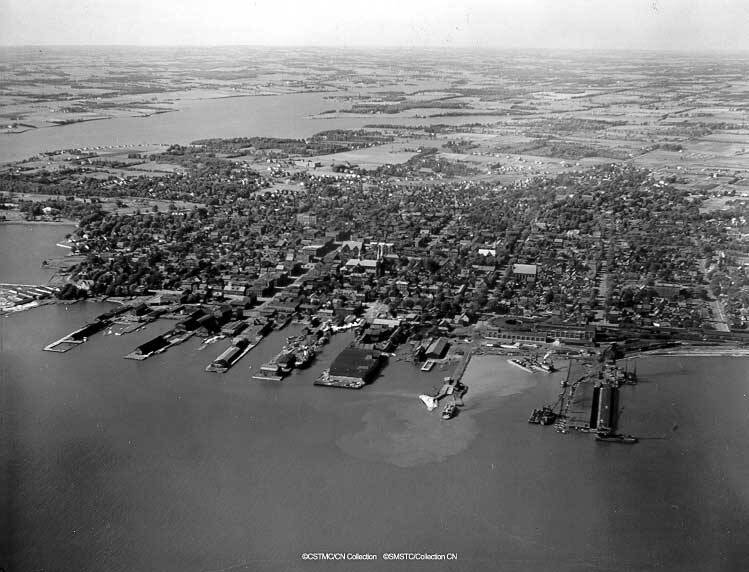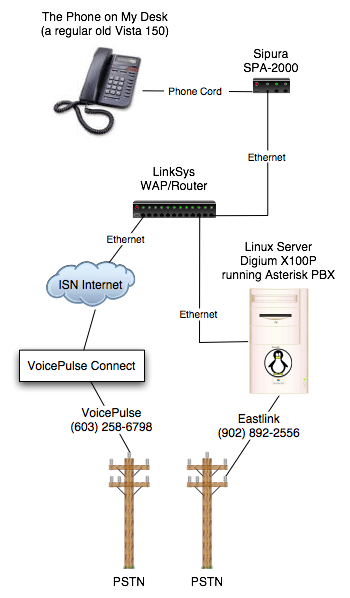As far as I know, I have never received an email from anyone in Montague.
However today I received an email from a man in Australia.
The weird thing is that it didn’t seem all that weird to me. It was like receiving an email from someone in Montague.
Ten years ago, getting an email from someone in Australia would have been very cool, and worthy of mention to your friends.
Twenty years ago, getting an email from someone in Australia would have just barely been possible for the average person.
And thirty years ago, the notion of having almost-immediate contact with someone in Australia would have been, for someone in Charlottetown, a once in a lifetime event. Can you imagine: “Peter, there’s a guy from Australia on the phone…” in 1974?
Happy New Year to all.
Almost every day I get an email message from someone who’s read something on this blog, looking for more information. And almost always the correspondent appears to think that I somehow officially represent that which I write about.
I’ve received email from people who want to donate clothes to the Red Cross. I’ve received email from people who want to purchase Cora’s Restaurant franchises for Mexico. I received email from people who want to purchase Cadbury’s chocolate bars.
The messages aren’t “hey, I read on your weblog about…” messages. They are “Dear Sir, I have several containers of clothing to donate; please tell me where to send it.” Or “We have several excellent sites for our new Cora’s here in Mexico; please have your franchise agent contact us.”
I assume that these queries come from people who go to Google, type in “red cross donate” or “Cora’s franchise” or “cadbury chocolate bars” and end up here. Then they simply click on contact and send off their email, without absorbing anything else (like the big “Reinvented” at the top of the page, or the sentence “Reinvented is two people, Peter and Johnny Rukavina.” at the top of the contact page.
This isn’t a problem in my life, and I’m not complaining, for it’s as much interesting as annoying. But it does suggest something somewhat disturbing about how people read the Internet, how they evaluate sources of information, and about how context appears not to matter.
Our librarian colleagues obviously have a lot of work ahead of them.
Here’s a great aerial shot of Charlottetown, undated, showing how different our waterfront once was:

I’ve been doing some additional work (aka play) with setting up a voice-over-IP network here in the office. I’ve now got Asterisk purring along smoothly, acting as the voicemail agent for all incoming calls. It’s working well with the Sipura SPA-2000, into which I’ve plugged a regular old Vista 150 desk phone.

Today I opened up a VoicePulse Connect! account, which lets me connect, through Asterisk and VoicePulse, to the PSTN, and to make long distance calls to anywhere in the US or Canada for just under 3 cents a minute.
I also purchased, for $7.99/month, a local DID number in Peterborough, New Hampshire. This lets people in the Peterborough local calling area phone a local number and get through to me. Other than the monthly fee, these incoming calls are free.
Setting up the VoicePulse Connect! account was extremely easy: the entire exercise, from start to having a number assigned to me, took less than 5 minutes. And my testing so far has resulted in excellent voice quality: Johnny phoned the DID number from Vancouver, my desk phone rang, and it sounded, well, like a telephone call should, with no pops, clicks, fade-outs, or digital interference. This despite the fact that I was sending a 1.1GB file over the same network at the same time.
Island alternoocrat Lobie Daughton sent around an email today to the friends of the Full Circle Cooperative School. Because he cc’d the email to all of the 44 friends, I got an interesting glimpse into “who’s who” in the so-called “alternative community” on the Island. When you see all of their names together, you realize there’s a potent force to be reckoned with there, from which Full Circle is perhaps the greatest and most public product.
I’ve talked to at least three sets of parents in recent years who have sent their kids to Full Circle, and all have told a similar tale of children flowering once the weight of public school was lifted from their shoulders. It’s an exciting place, and worthy of support. And because they’re a registered charity now, supporting them is tax deductible.
So today, while I’m in the business of giving out lifestyle suggestions, let me further suggest the following: if you were dissatisified with your own public school education, and wished that there had been an “out,” a place where learning happened differently, and with different emphasis, perhaps you could make a donation? Details are available on their website.
About 7 years ago I was standing in the lobby of the Royal York Hotel in Toronto. I was in Toronto as part of an ill-conceived provincial prospecting trip. The ill-conception mostly involved bringing me along, for my ideas about valuable prospecting activities were at odds with those of my colleagues.
My cell phone rang. I believe this may have been the first time my cell phone had ever rung outside of Prince Edward Island, so it was exciting. On the phone was Cindy Burton. She explained that her company, Rainforest Publications, based in British Columbia, was looking at moving to PEI; they were looking to move, and apparently Enterprise PEI had offered up some carrots. Cindy was looking for some pointers to ISPs and other technology types in Charlottetown, and I spent a couple of minutes on the phone pointing her in the right direction (I think I told her to call Kevin O’Brien, which was about as right a direction as you could get back then).
Fast forward a bit, and Rainforest was located on the Island. Fast forward a bit more and they were called iWave, and were a public company. And a bit more into the future and Cindy was out and Jamie Hill was in.
To this day, I’ve never met Cindy, but I recently stumbled across some of her recent endeavours, and they look interesting.
Her new corporate hat is Big Dog Solutions, which, says her website, “specializes in helping both non-profit agencies and start-up companies reach their fullest potential.” (see also here).
Cindy is also starting a dog-focused resort called Cool Dog Ranch (“Think of it as “club med” for you and your dog!” says the website) at an undisclosed location on the Island.
And she’s helping Junellen Claushiede open a retreat in Valleyfield called The Hearth that will “combine the best in organic cuisine and Island hospitality.”
And she’s leading a group called “The Catalyst Consortium” in some sort of mystery “exciting and innovative program” up west involving “five of PEI’s top consultants.”
Bravo! It’s good to see someone with energy and enthusiasm putting her talents to creative use here. I never could have imagined this, sitting on the end of a cell phone in the lobby in Toronto.
Do this. Right now. Please.
Go to your closet. Or your shoe tree (do people still have shoe trees?). Select a pair of shoes in need of repair. We all have them: the treasured pair of well-worn shoes that have fallen on bad times.
Sneakers and other plastic contraptions need not apply: we need something in need of repair that can, in fact, be repaired.
Now take these shoes and walk over to Currie’s Shoe Repair on Queen Street in Charlottetown. It’s on the west side, just south of Kent Street, near The Bookman. It’s in the basement.
Walk in the front door and down the stairs. And leave your shoes to be repaired.
They’ll probably be ready on Friday, or maybe early next week. You will be given a tag to take home to remind you. You will have a pleasant conversation with the owner.
Your life will improve immeasurably.
Do this. Right now. Please.
Here’s what’s new in the restaurant trade in Charlottetown.
The Taj Mahal, serving Indian cuisine on University Avenue, has closed its doors until June 1st. While I can’t claim to have had any barn-burner Indian meals there, one doesn’t want to look a gift horse in the mouth, and I’m sad to be without them for the long cold winter.
Perhaps it’s just me, but after a good start, things at Cora’s Breakfast and Lunch seem to be flagging a little. My perennial favourite the fruit crunch (granola, English cream, and lots of fresh fruit) used to be presented with much fanfare, and lots of extra fruit bonuses on the plate. This took something of the edge off paying close to $8.00 for a bowl of fruit. Lately, though, and especially this morning, this dish has been significantly reduced in spleandour: gone are any trace of plate garnishes, and the variety of fruit is diminished, with much more of the [traditional, for restaurants] reliance on melon and cantaloupe. Over Christmas, Catherine ordered the “St. Nicholas Special,” which is a hot turkey dinner with stuffing and mashed. She said, and I quote, “that’s the worse turkey dinner I’ve ever had.” Service at Cora’s has also suffered: it’s not unusual to see a line 5 or 6 customers deep waiting to cash out. I hope the downturn isn’t permanent, especially as they’re very nice to Oliver there, and he loves their pancakes.
The folks at the Formosa Tea House are hard at work in the former premises of Big Momma’s (which Gary insists on calling “The Windmill” for historical reasons). Word on the street is that they are shooting for a March opening, with a menu and hours expanded from the Formosa. No definitive word on the future of the University Ave. location; I hope they stick with it, because it’s so handy to the new office.
Catherine and I had dinner at the new St. James Place on Saturday (it’s in the old Home Hardware location on Kent Street). I had the vegetarian mushroom burger which, although too drenched in various fats, oils and cheeses to be considered technically “healthy” was very tasty. Catherine, who had breakfast there early Saturday, urged me on to the roasted potatoes over the jasmine rice, and they were, as she predicted, very good. Catherine had some sort of complex pasta dish that was baked in parchment. It didn’t change her life, but she enjoyed it. There were a wide variety of beers on tap (I’m not a beer drinker, but I was impressed with the various unusual names that seemed, to my untrained eye, quite exotic). The only downside food-wise was an expensive ($7.00) piece of mediocre raspberry cheesecake. It would have been pleasant at $3.95; at $7.00 I want the earth to move. I could take or leave the “ye olde” decor; I’m not sure why we feel compelled to recreate pretend olde interiors with fake plaster and fake beams, but I’m not mortally opposed to it, and the room has a nice feel. We were back last night around midnight, and the place was hopping with a crowd of 25-35 year olds, all looking very sophisticated. Presumably the St. James Place is an upgrade path from Myrons, and it certainly is handy by.
Now that I have used the phrase “handy by” I must stop writing.
 I am
I am